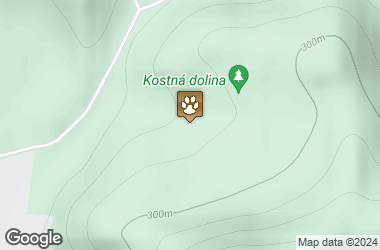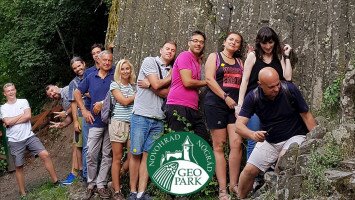
There is a palaeontologial site of European interest, discovered in the 2nd half of 19th century. It is a 380 m long scour gully, where you can find rests of tapir, rhinoceros, mastodon bones, as well as remnants of hyena, deer, wild boar, beaver, vole, monkey. The locality was proclaimed a National Nature Monument, covering an area of 4,92 ha.
During the last stage of the development of the maar, the volcanic structure got eroded due to an intensive uplift of the mountains in the Tertiary and Quaternary, and took its present a water-cut, which was formed in the Pleistocene, revealed the majority of the fossils of the Bone ravine. The Kostna-watercut became known in the second half of the 19th c., when Emil Ebeczky, a local landlord, sent the first finds of fossils to museums in Vienna and in Budapest. Identitified species: Tapirus priscus, Castor ebeczkyi, Tapirus hungaricus, Mastodon arvernensis and Mastodon borsoni, later discovered species: Rhinoceros cf. leptorhinus, Cervus (Axis) cf. pardinensis, Capreolus sp., Parailurus hungaricus, Mimomys hajnackensis, Mimomys hintoni, Trogontherium minus, Prospalax priscus, Crocuta perrieri, Hypolagus brachygnathus, Pliopetaurista pliocaenica, Castor fiber ssp., Ursidae gen. et sp., Baranomys loczyi, Mimomys (M.) hassiacus, M. (Cseria) stehlini, Ungaromys sp., Lutra cf. bravardi, Talpa cf. minor, T. fossilis, Desmana nehringi, Deinsdorfia hibbardi, Petenyia hungarica, Beremendia fissidens, Blarinoides mariae, Sus minor, Muntiacus sp., Cervus perrieri, C. pardinensis,Croizetoceros ramosus, Capreolus sp., Dicerorhinus jeanvireti, Scardinus erythrophthalmus, Tinca furcata, Esox sp., cf. Parasilurus sp, Pliobatrachus sp., Bufo bufo, Rana cf. temporaria, R. cf. arvalis es R. cf. ex gr. dalmatinalatastei, reptiles Emys orbicularis, Chelydra aff. decheny, Mergus sp.bird-species. Plant imprints are also known from the Bone Ravine: Pteris palaeoaurita, cf. Ginkgo adiantoides, Torreya fejfari, Picea sp., Salix sp., cf. Alnus sp., Betula sp., Carpinus grandis, cf. Pterocarya sp., Quercus ex gr. roburoides, Ulmus brauni, Zelkova zelkovifolia, Vitis cf. teutonica, Acer integerrimum, Acer sp., Tilia cf. platyphyllos and Buxus pliocaenica, Peridiniopsis borelinense, Selenopempyx sp., Halodinium sp., Leiosphaera sp. a Cyclopsiella sp. The results of the aforementioned studies reflect, that among the paleofossils of Kostna dolina there are both, aquatic and semi-aquatic elements, tropical species as well as open-field animals that refer to warm and moist climate. Their age is of Upper Pliocene, presumably 3.3 million years. The site is a type locality of the MN 16a mammal zone of European Neogene.















